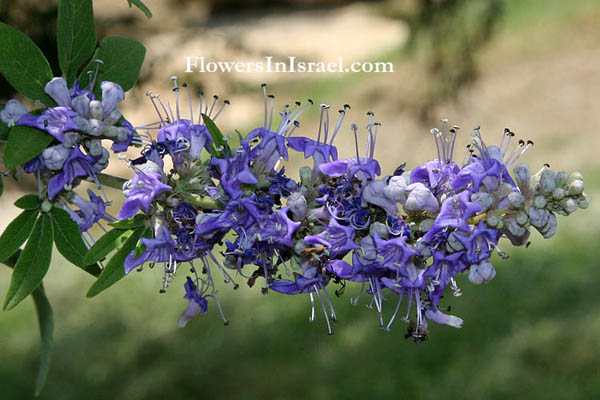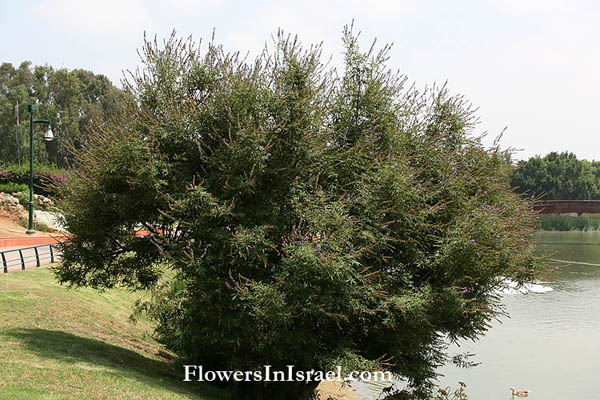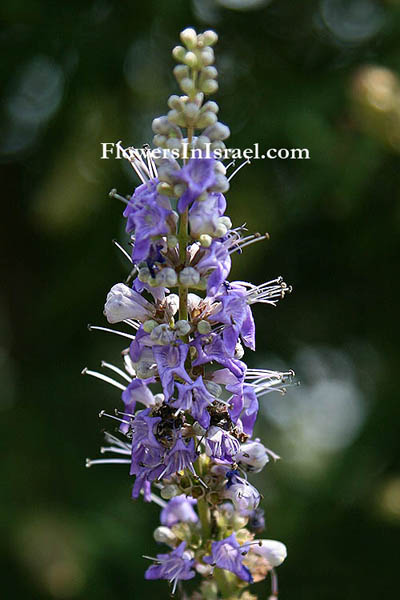Lilac chastetree, Chasteberry, Monk's Pepper, Hemp tree, Abraham's balm,
Hebrew: שיח-אברהם מצוי, Arabic: حبّ الفقد Habb al-faqd
| Scientific name: | Vitex agnus-castus L. | |
| Synonym name: | Agnus-castus robusta (Lebas) Carrière, Agnus-castus vulgaris Carrière, Vitex agnus Stokes | |
| Common name: | Lilac chastetree, Chasteberry, Monk's Pepper, Hemp tree, Abraham's balm | |
| Hebrew name: | שיח-אברהם מצוי | |
| Arabic name: | حبّ الفقد, Habb al-faqd | |
| Plant Family: | Verbenaceae, ורבניים |

|
| Life form: | Chamaephyte, semi-shrub | |
| Stems: | 3-5m high bush or tree; four-edged, light brown, branches which in the initial stages are covered with a fine down | |
| Leaves: | Opposite, compound, digitate | |
| Flowers: | Lilach, violet, on short peduncle, in whorled spikes | |
| Fruits / pods: | Capsule a roundish berry, red-black, four seeded, pitted | |
| Flowering Period: | June, July, August, September | |
| Habitat: | Humid habitats | |
| Distribution: | Mediterranean Woodlands and Shrublands, Semi-steppe shrublands, Deserts and extreme deserts | |
| Chorotype: | Mediterranean | |
| Summer shedding: | Perennating |

Derivation of the botanical name: Vitex, Latin, vitilis "made by plaiting", because the flexible branches of the tree were used in the construction of plaited fences (willow has similar semantics). agnus-castus, agnos, αγνοϛ, lamb, chaste, pure, holy; us, Latinizing suffix; castus, chaste, pure; chaste - chaste. In ancient Greece, the tree was called agnos [ἄγνος], which apparently the early Christians confused both with a similar Greek term hagnos [ἁγνός] "chaste", and with Latin agnus "lamb", the Christian symbol of purity. The English name for the tree is chaste tree or Dutch kuisboom. The Hebrew name: שיח-אברהם,siah avraham, "Abraham’s bush".
In antiquity the tree was known for its numerous medicinal qualities; according to Aelian and others, some of these qualities were related to the sexual life of women, associated with the opposing categories of chastity and fertility. On one hand, the leaves of the tree were reputed to temper sexual desire; thus the couches on which the Athenians who observed sexual continence during the Thesmophoria lay were made of agnus castus branches. On the other hand, the same agnus castus was known to favor menstruation and lactation. Seemingly opposed, these qualities are really not contradictory: the period of fecundity in women is incompatible with the development of an excessive sexuality. Thus the agnus castus can control sexual impulses while stimulating the powers of bleeding and hence of fecundity in a woman. 
|